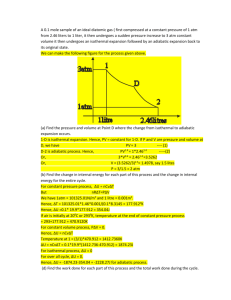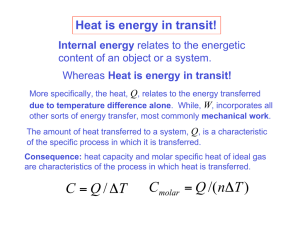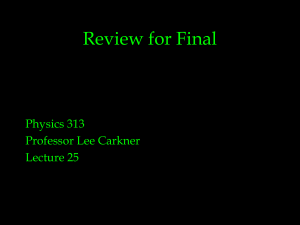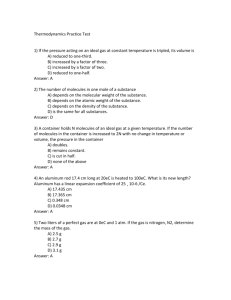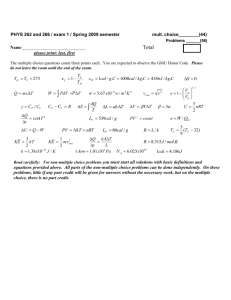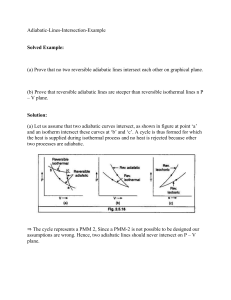Today’s Lecture Thermodynamic Processes
advertisement
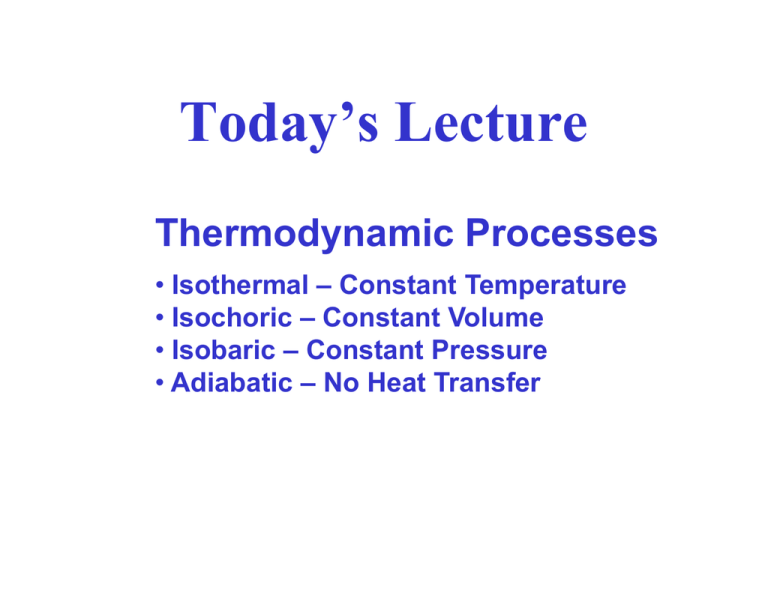
Today’s Lecture Thermodynamic Processes • Isothermal – Constant Temperature • Isochoric – Constant Volume • Isobaric – Constant Pressure • Adiabatic – No Heat Transfer First Law of Thermodynamics ΔU = Q − W change in the internal energy of the system net heat transferred to the system work done by the system The change in the internal energy of a system depends only on the net heat transferred to the system and the net work done by the system, and is independent of the particular processes involved. The equation is deceptively simple… One of the forms of the general law of conservation of energy. BUT! Be careful about the sign conventions. Positive Q is heat transferred to the system. Positive W is work done by the system. Work Done by a Gas Work done by a gas: Work done and heat transferred – our major concerns! W = FΔx = PAΔx = PΔV P – pressure of the gas; Δx – displacement of the piston, A – area of the piston Work is positive when the gas expands! Differential form: dW = Fdx = PAdx = PdV Integral form – valid for varying pressure: W = ∫ dW = ∫ PdV Work Done by a Gas Work done and heat transferred – our major concerns! W = ∫ dW = ∫ PdV P – (varying) pressure of the gas; dV – differential volume change ΔW = P ΔV Work equals area under curve on a P-V diagram Multiple Ways to Get From Initial to a Final State Is work going to be the same for different processes? NO! Is heat going to be the same? NO! Is internal energy going to be the same? YES! Internal energy is a function of state and will be the same independent of path between the states. Isothermal Process – T = const Isotherm nRT const P= = V V The work integral is straightforward. ΔU = Q − W Since the internal energy only depends on temperature: ΔU = 0 ⇒ Q =W Example: Isothermal Process - T = const A scuba diver at a depth of 25m, P = 3.5atm, exhales bubbles 8.0mm in radius. How much work is done by each bubble as it expands while it rises to the surface? Solution: From the ideal gas law we know for an isothermal process that the pressure and volume are inversely related. Example: Isothermal Process - T = const An ideal gas expands to 10 times its original volume, maintaining a temperature of 440K. The gas does 3.3kJ of work. (a) How much heat does the gas absorb? (b) How many moles of gas are there? Isochoric Process – ΔV = 0 ΔU = Q − W ΔW = PΔV ≡ 0 ΔU = Q = nCv ΔT The gas does no work for an isochoric process. The change in internal energy is the heat transfer. n – number of moles of the gas; Cv – molar specific heat at constant volume – heat capacity of one mole of the gas in an constant volume process. (Compare with Q=mcΔT) Why bother introducing a new parameter? For a gas, per mole is more convenient. 1 ΔU Cv = n ΔT Measuring Cv we learn about internal energy of the gas as a function of temperature! Isochoric Process – ΔV = 0 ΔU = Q − W ΔW = PΔV ≡ 0 ΔU = Q = nCv ΔT From the kinetic theory of gasses, we know that the (translational) kinetic energy/molecule is: If translational kinetic energy is the only form of internal energy then How much heat is required to raise the temperature of 500g of He by 10oC? Isobaric Processes – P = const. PV diagram for an isobaric process as the gas expands along the isobar from state 1 to state 2. Since the pressure of the gas remains constant, calculation of the work it does is particularly simple. V2 V2 V1 V1 W = ∫ PdV = P ∫ dV = P (V2 − V1 ) = PΔV What about internal energy and heat? Is T2< or >T1? Isobaric Processes – P = const. W = PΔV What about internal energy and heat? ΔU = Q − W and PV = nRT From the 1st law and equation for Cv: Q = ΔU + W = nCv ΔT + PΔV Ideal gas at constant pressure: PΔV = nRΔT hence Q = ΔU + W = nCv ΔT + nRΔT = n(Cv + R ) ΔT Isobaric Processes – P = const. Molar specific heat at constant pressure (definition): Hence Cp is: Why is specific heat at constant pressure higher than at constant volume? C p = Cv + R What is the specific heat at constant pressure for He gas? Why was there no difference in specific heats for solids? Review of our Thermodynamic Processes ΔU = Q − W PV = nRT W = ∫ PdV Adiabatic Process – Q = 0 There is no heat transfer for an adiabatic process Implies thermal insulation or process happens quickly. Q=0 PV = nRT ΔU = −W W = ∫ PdV Adiabatic Process – Q = 0 Q=0 ΔU = −W Positive work, W, is done by the expanding gas at expense of reduction of its internal energy. Since there is no heat supplied from the outside to replenish the gas energy the temperature declines. Ti Tf Vi Vf Work can be expressed in terms of -ΔT or -Δ(PV) Adiabatic Process – Q = 0 Q=0 ΔU = −W We now know the work done by an ideal gas during an adiabatic expansion, but how do pressure and temperature behave? From the ideal gas law: From the 1st law: As an exercise for the student/professor Ti Tf Vi Vf Adiabatic Process – Q = 0 Q=0 ΔU = −W A gas with γ = 1.4 at 105Pa occupies 5L. It is compressed adiabatically to 2.5L. Tf (a) What is its final pressure? Ti Vf Vi (b) What is ratio of the final and initial temperatures? Adiabatic Process – Q = 0 Q=0 ΔU = −W A gas with γ = 1.4 at 105Pa occupies 5L. It is compressed adiabatically to 2.5L. Tf Ti Vf (c) What work is required to compress the gas? Vi Why is the work negative? Adiabatic Process – Q = 0 Blue arrow – the gas is expending, does a positive work and cooled down (“goes to lower isotherms”)… Ti Tf Vi Vf Red arrow – the gas is contracting, driven by some external forces. It does negative work and heats up (“goes to higher isotherms”.) An adiabatic process is described by: γ = Cp/Cv a constant, where 1< γ < 2 It may be different for different gases! In contrast an isothermal process is described by: Adiabatic and Isothermal Process for the Same Gas? How does it happen that two equations may work for the same ideal gas? γ γ 1 1 2 2 1 1 2 2 PV = P V PV = P V Are they both compatible with the ideal gas law? PV = nRT Yes, they are both compatible! Because the ideal gas law has 3 variables, and P as a function of V in a particular process depends on what happens to the temperature! Isothermal Adiabatic Example: Isothermal vs Adiabatic Expansion Consider expanding .06mol of gas with γ = 1.4 from 2atm to 1atm. Starting at T=300K. Find the final temperature and volume for both an adiabatic and isothermal process. From the ideal gas law, the initial volume is: For isothermal expansion the volume doubles. For an adiabatic expansion: Fire Syringe: A small wad of cotton bursts into flame when the air in a narrow tube is rapidly compressed. Four Processes Between Two Isotherms How do you order them in terms of heat transferred to the gas? Things to remember: U depends on T only! W = ∫ PdV Q = ΔU + W The largest work done by the gas will require the most heat transfer! What is the heat transferred to the gas in process 3? Q = ΔU + W W = ∫ PdV ΔU = nCv ΔT PV nT = R P2V 2 − P1V1 nΔT = R Summary of Temperature Changes Process 1 – Adiabatic Q = 0 => ΔU = -W => T1 < Ta Process 2 – Isochoric W = 0 => Q = nCvΔT => T2 < Ta Process 3 – Isobaric P3 = Pa => Q = nCpΔT => T3 > Ta Process 4 – Isothermal T4 = Ta => ΔU = 0 => T4 = Ta Summary of the First Law of Thermodynamics First Law of Thermodynamics • U only depends on the temperature of the gas • Q is positive when heat is added to the gas • W is positive when the gas does work Thermodynamic processes, Quasi-static - work is given by Isothermal – constant temperature Isochoric – constant volume Isobaric – constant pressure Adiabatic – no heat transfer



